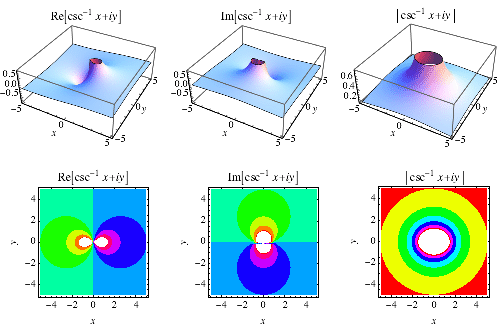 |
The inverse cosecant is the multivalued function (Zwillinger 1995, p. 465),
also denoted
(Abramowitz and Stegun 1972, p. 79; Spanier and Oldham 1987, p. 332; Harris
and Stocker 1998, p. 315; Jeffrey 2000, p. 125), that is the inverse
function of the cosecant. The variants
(e.g., Beyer 1987, p. 141; Bronshtein and Semendyayev,
1997, p. 70) and
are sometimes used to refer to explicit principal
values of the inverse cosecant, although this distinction is not always made
(e.g,. Zwillinger 1995, p. 466). Worse yet, the notation
is sometimes used for the principal value, with
being used for the multivalued
function (Abramowitz and Stegun 1972, p. 80). Note that in the notation
(commonly used in North America
and in pocket calculators worldwide),
is the cosecant and the superscript
denotes an inverse
function, not the multiplicative inverse.
The principal value of the inverse cosecant is implemented as ArcCsc[x] in the Wolfram Language.
The inverse cosecant is a multivalued function and hence requires a branch cut in the complex
plane, which the Wolfram Language's
convention places at .
This follows from the definition of
as
|
(1)
|
The derivative of is given by
|
(2)
|
which simplifies to
|
(3)
|
for .
Its indefinite integral is
|
(4)
|
which simplifies to
|
(5)
|
for .
The inverse cosecant has Taylor series about infinity of
|
(6)
| |||
|
(7)
| |||
|
(8)
|
(OEIS A055786 and A002595), where
is a Legendre polynomial and
is a Pochhammer symbol.
The inverse cosecant satisfies
|
(9)
|
for ,
|
(10)
| |||
|
(11)
|
for all complex ,
and
|
(12)
| |||
|
(13)
| |||
|
(14)
|